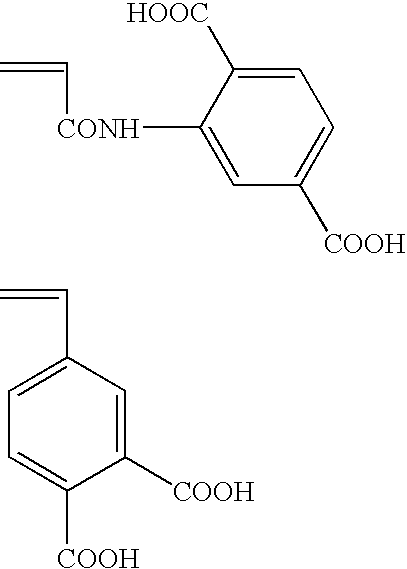Planographic printing plate precursor
a technology of planographic printing plate and precursor, which is applied in the direction of auxillary/base layers of photosensitive materials, instruments, photosensitive materials, etc., can solve the problems of insufficient printing durability, non-image area contamination, and decreased adhesion of the support to the recording layer to be formed thereon, etc., to achieve excellent removal ability, excellent adhesion to removal solution, and improved printing durability
- Summary
- Abstract
- Description
- Claims
- Application Information
AI Technical Summary
Benefits of technology
Problems solved by technology
Method used
Image
Examples
example
[0279] The invention will be explained in more detail by way of Examples, but the invention is not limited to them.
[Synthesis of Specified Polymer (P-1)]
[0280] A mixed solution of 13.0 g of 2-hydroxyethyl methacrylate (0.1 mol), 7.92 g of pyridine and 200 ml of toluene was added dropwise to a 500 ml three-neck flask containing 21.0 g of trimellitic anhydride chloride (0.1 mol) and 130 ml toluene being stirred under ice-cooling over a period of 30 minutes. Thereafter, the mixture was further reacted at room temperature for 1 hour, the reaction solvent was removed, and precipitated crystals were washed with hexane. 100 ml of water was added to the 24.95 g of the resulting crystals (0.082 mol), and the mixture was stirred, followed by extraction with diisopropyl ether. The solvent was removed from the solution, followed by drying to obtain 15.28 g (yield 47.4%) of a specified monomer (M-1). The structure of the specified monomer (M-1) is shown below.
[0281] A solution of 22.56 g (0....
examples 1 , 3 , 4 and 7
Examples 1, 3, 4 and 7
[Formation of Recording Layer]
-Synthesis of Polymer 1-
[0305] A 500 ml three-neck flask equipped with a stirrer, a condensing tube and an addition funnel was charged with 31.0 g (0.36 mole) of methacrylic acid, 39.1 g (0.36 mole) of ethyl chloroformate and 200 ml of acetonitrile, and the mixture was stirred while it was cooled with an ice water bath. To this mixture was added dropwise 36.4 g (0.36 mole) of triethylamine over about 1 hour with the addition funnel. After addition, the ice water bath was removed, and the mixture was stirred at room temperature for 30 minutes.
[0306] To this reaction mixture was added 51.7 g (0.30 mole) of p-aminobenzenesulfonamide, and the mixture was stirred for 1 hour while it was warmed to 70° C. with an oil bath. After completion of the reaction, this mixture was placed into 1 liter of water while this water was stirred, and the resulting mixture was stirred for 30 minutes. This mixture was filtered to remove precipitates, w...
examples 2 , 5 and 6
Examples 2, 5 and 6
[0310] The following coating solution 3 for forming a recording layer was coated on the thus formed intermediate layer at a coating amount after drying of 1.2 g / m2, to obtain each of planographic printing plate precursors of Examples 2, 5 and 6.
m,p-cresol novolak 0.93 g(m / p ratio = 6 / 4, weight average molecular weight 7,300,containing 0.4 mass % of unreacted cresol)Vinyl polymer (1) having the following structure 0.07 gCyanine dye A (having the above structure)0.017 gCyanine dye B (having the following structure)0.023 g2,4,6-Tris(hexyloxy)benzenediazonium-2-hydroxy- 0.01 g4-methoxybenzophenone-5-sulfonatep-toluenesulfonic acid0.003 gCyclohexane-1,2-dicarboxylic anhydride 0.06 gDye of Victoria Pure Blue BOH in which the0.015 gcounteranion was changed to 1-naphthalenesulfonic acid anionFluorine-based surfactant 0.02 g(Megafac F-176, manufactured by Dainippon Ink andChemicals, Incorporated)Methyl ethyl ketone 15 g1-Methoxy-2-propanol 7 gCyanine dye BVinyl polyme...
PUM
 Login to View More
Login to View More Abstract
Description
Claims
Application Information
 Login to View More
Login to View More - R&D
- Intellectual Property
- Life Sciences
- Materials
- Tech Scout
- Unparalleled Data Quality
- Higher Quality Content
- 60% Fewer Hallucinations
Browse by: Latest US Patents, China's latest patents, Technical Efficacy Thesaurus, Application Domain, Technology Topic, Popular Technical Reports.
© 2025 PatSnap. All rights reserved.Legal|Privacy policy|Modern Slavery Act Transparency Statement|Sitemap|About US| Contact US: help@patsnap.com



